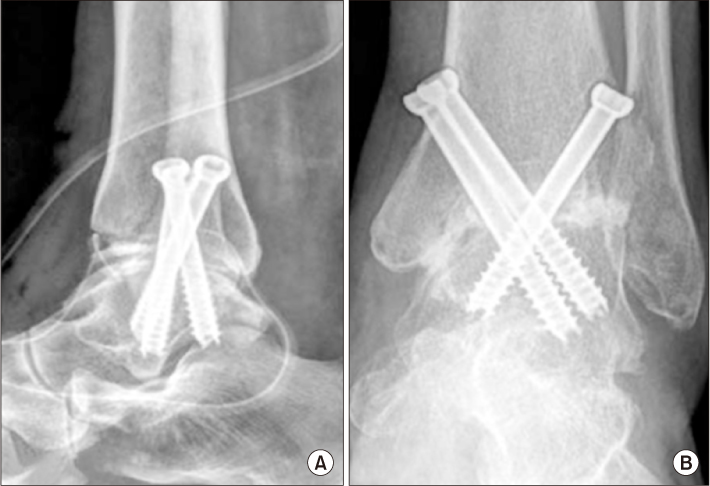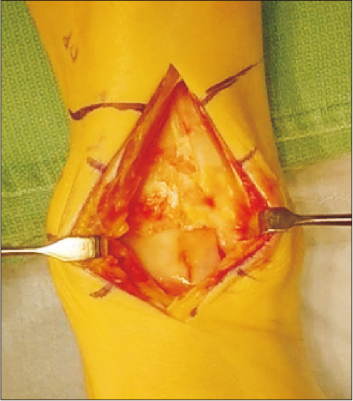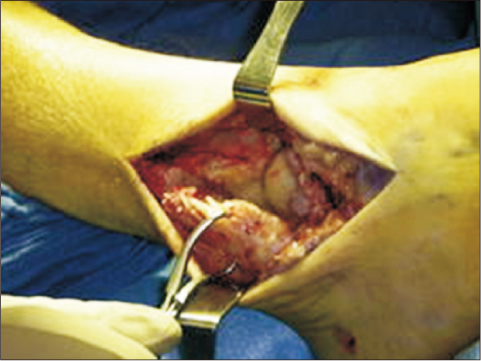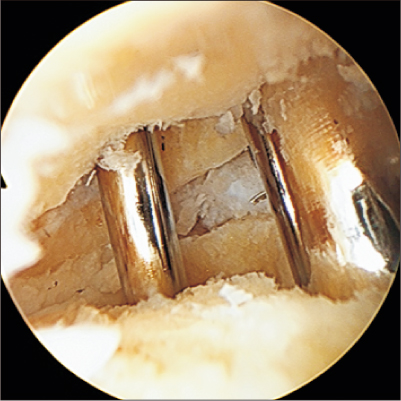J Korean Foot Ankle Soc.
2018 Mar;22(1):1-7. 10.14193/jkfas.2018.22.1.1.
Ankle Arthrodesis
- Affiliations
-
- 1Department of Orthopedics, Soonchunhyang University Seoul Hospital, Seoul, Korea. orthochun@gmail.com
- KMID: 2407368
- DOI: http://doi.org/10.14193/jkfas.2018.22.1.1
Abstract
- Ankle arthrodesis is a common and standard treatment for patients with end-stage ankle arthritis. The surgical goals of ankle arthrodesis are to obtain bony union between the tibia and talus with adequate alignment, and provide a pain-free plantigrade foot for weightbearing activities. To achieve successful fusion, the surgeon should closely examine the patient's factors before surgery, particularly the following: adjacent arthritis and deformity, infection, avascular necrosis of talus, Charcot arthropathy, and rheumatoid arthritis. Recently, ankle arthroplasty has been reported to provide satisfactory clinical results. On the other hand, long-term follow-up results are still lacking, and considering the various complications of arthroplasty, ankle arthrodesis is still the primary surgical treatment for advanced arthritis of the ankle joint.
Keyword
MeSH Terms
Figure
Reference
-
1. Mann RA, Rongstad KM. Arthrodesis of the ankle: a critical analysis. Foot Ankle Int. 1998; 19:3–9.
Article2. Raikin SM. Arthrodesis of the ankle: arthroscopic, mini-open, and open techniques. Foot Ankle Clin. 2003; 8:347–359.
Article3. Katcherian DA. Treatment of ankle arthrosis. Clin Orthop Relat Res. 1998; (349):48–57.
Article4. van Valburg AA, van Roermund PM, Marijnissen AC, van Melkebeek J, Lammens J, Verbout AJ, et al. Joint distraction in treatment of osteoarthritis: a two-year follow-up of the ankle. Osteoarthritis Cartilage. 1999; 7:474–479.
Article5. Agel J, Coetzee JC, Sangeorzan BJ, Roberts MM, Hansen ST Jr. Functional limitations of patients with end-stage ankle arthrosis. Foot Ankle Int. 2005; 26:537–539.
Article6. Glazebrook M, Daniels T, Younger A, Foote CJ, Penner M, Wing K, et al. Comparison of health-related quality of life between patients with end-stage ankle and hip arthrosis. J Bone Joint Surg Am. 2008; 90:499–505.
Article7. Haddad SL, Coetzee JC, Estok R, Fahrbach K, Banel D, Nalysnyk L. Intermediate and long-term outcomes of total ankle arthroplasty and ankle arthrodesis. A systematic review of the literature. J Bone Joint Surg Am. 2007; 89:1899–1905.
Article8. Daniels TR, Younger AS, Penner M, Wing K, Dryden PJ, Wong H, et al. Intermediate-term results of total ankle replacement and ankle arthrodesis: a COFAS multicenter study. J Bone Joint Surg Am. 2014; 96:135–142.
Article9. Krause FG, Windolf M, Bora B, Penner MJ, Wing KJ, Younger AS. Impact of complications in total ankle replacement and ankle arthrodesis analyzed with a validated outcome measurement. J Bone Joint Surg Am. 2011; 93:830–839.
Article10. Jordan RW, Chahal GS, Chapman A. Is end-stage ankle arthrosis best managed with total ankle replacement or arthrodesis? A systematic review. Adv Orthop. 2014; 2014:986285.
Article11. SooHoo NF, Zingmond DS, Ko CY. Comparison of reoperation rates following ankle arthrodesis and total ankle arthroplasty. J Bone Joint Surg Am. 2007; 89:2143–2149.
Article12. Schuh R, Hofstaetter J, Krismer M, Bevoni R, Windhager R, Trnka HJ. Total ankle arthroplasty versus ankle arthrodesis. Comparison of sports, recreational activities and functional outcome. Int Orthop. 2012; 36:1207–1214.
Article13. Yasui Y, Vig KS, Murawski CD, Desai P, Savage-Elliott I, Kennedy JG. Open versus arthroscopic ankle arthrodesis: a comparison of subsequent procedures in a large database. J Foot Ankle Surg. 2016; 55:777–781.
Article14. Terrell RD, Montgomery SR, Pannell WC, Sandlin MI, Inoue H, Wang JC, et al. Comparison of practice patterns in total ankle replacement and ankle fusion in the United States. Foot Ankle Int. 2013; 34:1486–1492.
Article15. Soren A, Waugh TR. The historical evolution of arthrodesis of the foot. Int Orthop. 1980; 4:3–11.
Article16. Charnley J. Compression arthrodesis of the ankle and shoulder. J Bone Joint Surg Br. 1951; 33B:180–191.
Article17. Cottino U, Collo G, Morino L, Cosentino A, Gallina V, Deregibus M, et al. Arthroscopic ankle arthrodesis: a review. Curr Rev Musculoskelet Med. 2012; 5:151–155.
Article18. Miehlke W, Gschwend N, Rippstein P, Simmen BR. Compression arthrodesis of the rheumatoid ankle and hindfoot. Clin Orthop Relat Res. 1997; (340):75–86.
Article19. Mann RA, Van Manen JW, Wapner K, Martin J. Ankle fusion. Clin Orthop Relat Res. 1991; (268):49–55.20. Flückiger G, Weber M. [The transfibular approach for ankle arthrodesis]. Oper Orthop Traumatol. 2005; 17:361–379. German.21. Colman AB, Pomeroy GC. Transfibular ankle arthrodesis with rigid internal fixation: an assessment of outcome. Foot Ankle Int. 2007; 28:303–307.
Article22. Klaue K, Bursic D. [The dorsolateral approach to the ankle for arthrodesis]. Oper Orthop Traumatol. 2005; 17:380–391. German.23. Ogilvie-Harris DJ, Lieberman I, Fitsialos D. Arthroscopically assisted arthrodesis for osteoarthrotic ankles. J Bone Joint Surg Am. 1993; 75:1167–1174.
Article24. Ahmad J, Raikin SM. Ankle arthrodesis: the simple and the complex. Foot Ankle Clin. 2008; 13:381–400. viii
Article25. Miller SD, Paremain GP, Myerson MS. The miniarthrotomy technique of ankle arthrodesis: a cadaver study of operative vascular compromise and early clinical results. Orthopedics. 1996; 19:425–430.
Article26. Paremain GD, Miller SD, Myerson MS. Ankle arthrodesis: results after the miniarthrotomy technique. Foot Ankle Int. 1996; 17:247–252.
Article27. Coester LM, Saltzman CL, Leupold J, Pontarelli W. Long-term results following ankle arthrodesis for post-traumatic arthritis. J Bone Joint Surg Am. 2001; 83:219–228.
Article28. Baumhauer JF, Lu AP, DiGiovanni BF. Arthodesis of the infected ankle and subtalar joint. Foot Ankle Clin. 2002; 7:175–190.
Article29. Ahmad J, Pour AE, Raikin SM. The modified use of a proximal humeral locking plate for tibiotalocalcaneal arthrodesis. Foot Ankle Int. 2007; 28:977–983.
Article30. Kelly IP, Easley ME. Treatment of stage 3 adult acquired flatfoot. Foot Ankle Clin. 2001; 6:153–166.
Article31. Kelly IP, Nunley JA. Treatment of stage 4 adult acquired flatfoot. Foot Ankle Clin. 2001; 6:167–178.
Article32. Felix NA, Kitaoka HB. Ankle arthrodesis in patients with rheumatoid arthritis. Clin Orthop Relat Res. 1998; (349):58–64.
Article33. Berkowitz MJ, Sanders RW, Walling AK. Salvage arthrodesis after failed ankle replacement: surgical decision making. Foot Ankle Clin. 2012; 17:725–740.34. Patterson BM, Inglis AE, Moeckel BH. Anterior sliding graft for tibiotalar arthrodesis. Foot Ankle Int. 1997; 18:330–334.
Article35. Thordarson DB, Kuehn S. Use of demineralized bone matrix in ankle/hindfoot fusion. Foot Ankle Int. 2003; 24:557–560.
Article





